吴裕雄 python 机器学习——集成学习梯度提升决策树GradientBoostingRegressor回归模型
import numpy as np
import matplotlib.pyplot as plt from sklearn import datasets,ensemble
from sklearn.model_selection import train_test_split def load_data_regression():
'''
加载用于回归问题的数据集
'''
#使用 scikit-learn 自带的一个糖尿病病人的数据集
diabetes = datasets.load_diabetes()
# 拆分成训练集和测试集,测试集大小为原始数据集大小的 1/4
return train_test_split(diabetes.data,diabetes.target,test_size=0.25,random_state=0) #集成学习梯度提升决策树GradientBoostingRegressor回归模型
def test_GradientBoostingRegressor(*data):
X_train,X_test,y_train,y_test=data
regr=ensemble.GradientBoostingRegressor()
regr.fit(X_train,y_train)
print("Training score:%f"%regr.score(X_train,y_train))
print("Testing score:%f"%regr.score(X_test,y_test)) # 获取分类数据
X_train,X_test,y_train,y_test=load_data_regression()
# 调用 test_GradientBoostingRegressor
test_GradientBoostingRegressor(X_train,X_test,y_train,y_test)

def test_GradientBoostingRegressor_num(*data):
'''
测试 GradientBoostingRegressor 的预测性能随 n_estimators 参数的影响
'''
X_train,X_test,y_train,y_test=data
nums=np.arange(1,200,step=2)
fig=plt.figure()
ax=fig.add_subplot(1,1,1)
testing_scores=[]
training_scores=[]
for num in nums:
regr=ensemble.GradientBoostingRegressor(n_estimators=num)
regr.fit(X_train,y_train)
training_scores.append(regr.score(X_train,y_train))
testing_scores.append(regr.score(X_test,y_test))
ax.plot(nums,training_scores,label="Training Score")
ax.plot(nums,testing_scores,label="Testing Score")
ax.set_xlabel("estimator num")
ax.set_ylabel("score")
ax.legend(loc="lower right")
ax.set_ylim(0,1.05)
plt.suptitle("GradientBoostingRegressor")
plt.show() # 调用 test_GradientBoostingRegressor_num
test_GradientBoostingRegressor_num(X_train,X_test,y_train,y_test)
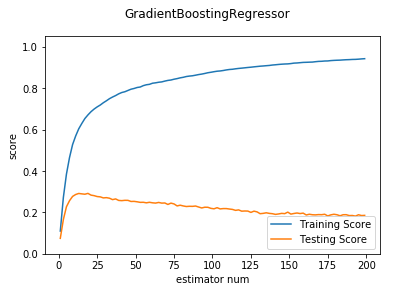
def test_GradientBoostingRegressor_maxdepth(*data):
'''
测试 GradientBoostingRegressor 的预测性能随 max_depth 参数的影响
'''
X_train,X_test,y_train,y_test=data
maxdepths=np.arange(1,20)
fig=plt.figure()
ax=fig.add_subplot(1,1,1)
testing_scores=[]
training_scores=[]
for maxdepth in maxdepths:
regr=ensemble.GradientBoostingRegressor(max_depth=maxdepth,max_leaf_nodes=None)
regr.fit(X_train,y_train)
training_scores.append(regr.score(X_train,y_train))
testing_scores.append(regr.score(X_test,y_test))
ax.plot(maxdepths,training_scores,label="Training Score")
ax.plot(maxdepths,testing_scores,label="Testing Score")
ax.set_xlabel("max_depth")
ax.set_ylabel("score")
ax.legend(loc="lower right")
ax.set_ylim(-1,1.05)
plt.suptitle("GradientBoostingRegressor")
plt.show() # 调用 test_GradientBoostingRegressor_maxdepth
test_GradientBoostingRegressor_maxdepth(X_train,X_test,y_train,y_test)

def test_GradientBoostingRegressor_learning(*data):
'''
测试 GradientBoostingRegressor 的预测性能随 learning_rate 参数的影响
'''
X_train,X_test,y_train,y_test=data
learnings=np.linspace(0.01,1.0)
fig=plt.figure()
ax=fig.add_subplot(1,1,1)
testing_scores=[]
training_scores=[]
for learning in learnings:
regr=ensemble.GradientBoostingRegressor(learning_rate=learning)
regr.fit(X_train,y_train)
training_scores.append(regr.score(X_train,y_train))
testing_scores.append(regr.score(X_test,y_test))
ax.plot(learnings,training_scores,label="Training Score")
ax.plot(learnings,testing_scores,label="Testing Score")
ax.set_xlabel("learning_rate")
ax.set_ylabel("score")
ax.legend(loc="lower right")
ax.set_ylim(-1,1.05)
plt.suptitle("GradientBoostingRegressor")
plt.show() # 调用 test_GradientBoostingRegressor_learning
test_GradientBoostingRegressor_learning(X_train,X_test,y_train,y_test)
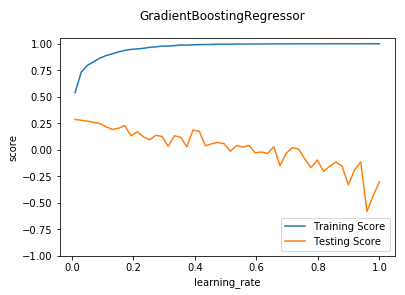
def test_GradientBoostingRegressor_subsample(*data):
'''
测试 GradientBoostingRegressor 的预测性能随 subsample 参数的影响
'''
X_train,X_test,y_train,y_test=data
fig=plt.figure()
ax=fig.add_subplot(1,1,1)
subsamples=np.linspace(0.01,1.0,num=20)
testing_scores=[]
training_scores=[]
for subsample in subsamples:
regr=ensemble.GradientBoostingRegressor(subsample=subsample)
regr.fit(X_train,y_train)
training_scores.append(regr.score(X_train,y_train))
testing_scores.append(regr.score(X_test,y_test))
ax.plot(subsamples,training_scores,label="Training Score")
ax.plot(subsamples,testing_scores,label="Training Score")
ax.set_xlabel("subsample")
ax.set_ylabel("score")
ax.legend(loc="lower right")
ax.set_ylim(-1,1.05)
plt.suptitle("GradientBoostingRegressor")
plt.show() # 调用 test_GradientBoostingRegressor_subsample
test_GradientBoostingRegressor_subsample(X_train,X_test,y_train,y_test)
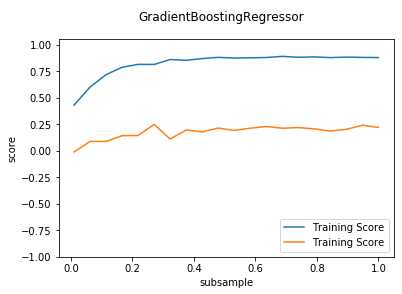
def test_GradientBoostingRegressor_loss(*data):
'''
测试 GradientBoostingRegressor 的预测性能随不同的损失函数和 alpha 参数的影响
'''
X_train,X_test,y_train,y_test=data
fig=plt.figure()
nums=np.arange(1,200,step=2)
########## 绘制 huber ######
ax=fig.add_subplot(2,1,1)
alphas=np.linspace(0.01,1.0,endpoint=False,num=5)
for alpha in alphas:
testing_scores=[]
training_scores=[]
for num in nums:
regr=ensemble.GradientBoostingRegressor(n_estimators=num,loss='huber',alpha=alpha)
regr.fit(X_train,y_train)
training_scores.append(regr.score(X_train,y_train))
testing_scores.append(regr.score(X_test,y_test))
ax.plot(nums,training_scores,label="Training Score:alpha=%f"%alpha)
ax.plot(nums,testing_scores,label="Testing Score:alpha=%f"%alpha)
ax.set_xlabel("estimator num")
ax.set_ylabel("score")
ax.legend(loc="lower right",framealpha=0.4)
ax.set_ylim(0,1.05)
ax.set_title("loss=%huber")
plt.suptitle("GradientBoostingRegressor")
#### 绘制 ls 和 lad
ax=fig.add_subplot(2,1,2)
for loss in ['ls','lad']:
testing_scores=[]
training_scores=[]
for num in nums:
regr=ensemble.GradientBoostingRegressor(n_estimators=num,loss=loss)
regr.fit(X_train,y_train)
training_scores.append(regr.score(X_train,y_train))
testing_scores.append(regr.score(X_test,y_test))
ax.plot(nums,training_scores,label="Training Score:loss=%s"%loss)
ax.plot(nums,testing_scores,label="Testing Score:loss=%s"%loss)
ax.set_xlabel("estimator num")
ax.set_ylabel("score")
ax.legend(loc="lower right",framealpha=0.4)
ax.set_ylim(0,1.05)
ax.set_title("loss=ls,lad")
plt.suptitle("GradientBoostingRegressor")
plt.show() # 调用 test_GradientBoostingRegressor_loss
test_GradientBoostingRegressor_loss(X_train,X_test,y_train,y_test)
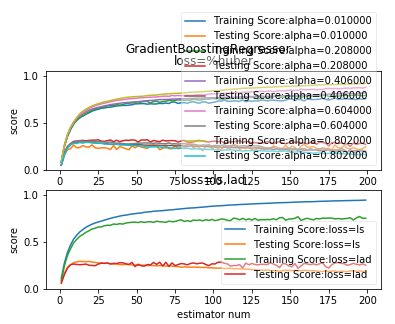
def test_GradientBoostingRegressor_max_features(*data):
'''
测试 GradientBoostingRegressor 的预测性能随 max_features 参数的影响
'''
X_train,X_test,y_train,y_test=data
fig=plt.figure()
ax=fig.add_subplot(1,1,1)
max_features=np.linspace(0.01,1.0)
testing_scores=[]
training_scores=[]
for features in max_features:
regr=ensemble.GradientBoostingRegressor(max_features=features)
regr.fit(X_train,y_train)
training_scores.append(regr.score(X_train,y_train))
testing_scores.append(regr.score(X_test,y_test))
ax.plot(max_features,training_scores,label="Training Score")
ax.plot(max_features,testing_scores,label="Training Score")
ax.set_xlabel("max_features")
ax.set_ylabel("score")
ax.legend(loc="lower right")
ax.set_ylim(0,1.05)
plt.suptitle("GradientBoostingRegressor")
plt.show() # 调用 test_GradientBoostingRegressor_max_features
test_GradientBoostingRegressor_max_features(X_train,X_test,y_train,y_test)
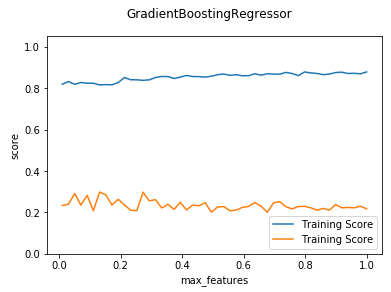
吴裕雄 python 机器学习——集成学习梯度提升决策树GradientBoostingRegressor回归模型的更多相关文章
- 吴裕雄 python 机器学习——集成学习随机森林RandomForestRegressor回归模型
import numpy as np import matplotlib.pyplot as plt from sklearn import datasets,ensemble from sklear ...
- 吴裕雄 python 机器学习——集成学习随机森林RandomForestClassifier分类模型
import numpy as np import matplotlib.pyplot as plt from sklearn import datasets,ensemble from sklear ...
- 吴裕雄 python 机器学习——集成学习AdaBoost算法回归模型
import numpy as np import matplotlib.pyplot as plt from sklearn import datasets,ensemble from sklear ...
- 吴裕雄 python 机器学习——集成学习AdaBoost算法分类模型
import numpy as np import matplotlib.pyplot as plt from sklearn import datasets,ensemble from sklear ...
- 吴裕雄 python 机器学习——数据预处理字典学习模型
from sklearn.decomposition import DictionaryLearning #数据预处理字典学习DictionaryLearning模型 def test_Diction ...
- 吴裕雄 python 机器学习——人工神经网络感知机学习算法的应用
import numpy as np from matplotlib import pyplot as plt from sklearn import neighbors, datasets from ...
- 吴裕雄 python 机器学习——人工神经网络与原始感知机模型
import numpy as np from matplotlib import pyplot as plt from mpl_toolkits.mplot3d import Axes3D from ...
- 吴裕雄 python 机器学习——分类决策树模型
import numpy as np import matplotlib.pyplot as plt from sklearn import datasets from sklearn.model_s ...
- 吴裕雄 python 机器学习——回归决策树模型
import numpy as np import matplotlib.pyplot as plt from sklearn import datasets from sklearn.model_s ...
随机推荐
- javaWeb快速入门+——初体验-HelloWorld
文章转载自 https://www.cnblogs.com/1906859953Lucas/p/10821840.html 练习成品下载 https://www.lanzous.com/i9fljkj ...
- EL表达式无法获取boolean类型变量值
今天调试个程序, 有个名为isAdmin的boolean类型的变量在jsp页面获取到的值为空, 这根本就是没获取到或者变量不存在的状况啊,但是在Action中明明是赋值成false了. 上网查了一下有 ...
- windows10(家庭版)+ laradock 安装踩坑记一记
Docker 安装: 首先我们需要在系统安装 Docker 的免费社区版,官方提供 Windows.Mac 及 Linux 等版本下载:下载地址.下载操作系统对应版本后,按照引导流程安装,最后打开 D ...
- jmeter请求报错
jmeter发送json数据,报405.400错误解决方案: https://www.cnblogs.com/sunny-sl/p/8044284.html 405:Content-Type不对 40 ...
- 温故知新的经典贪心题目:今年暑假不AC?
情景: “今年暑假不AC?” “是的.” “那你干什么呢?” “看世界杯呀,笨蛋!” “@#$%^&*%...” 确实如此,世界杯来了,球迷的节日也来了,估计很多ACMer也会抛开电脑,奔向电 ...
- 【做题笔记】洛谷P1506 拯救oibh总部
跑一遍染色法,最后判断哪些位置没被染色即可 一些技巧: 为了判断方便,把字符转换成 int 型的数字. 注意边界问题 详细解释见代码 #include <iostream> #includ ...
- RabbitMQ使用注意事项
用ConnectionFactory创建的TCP连接要复用,因为创建新的TCP连接比较耗时. IModel(信道)是轻量级的,可以用时创建. channel.BasicQos(0, 1, false) ...
- OpenCV: “vector”: 未声明的标识符和Vector不是模板
漏写using namespace std: 会出现此错误“vector”: 未声明的标识符或者是将“vector”写成‘Vector’会出现Vector不是模板的错误:改正即可
- 【Python】字符串切片
- classification tips 01: npy file
numpy array storation; npy/npz file. 文件存取的格式:二进制和文本.二进制格式的文件又分为NumPy专用的格式化二进制类型和无格式类型. numpy文件存取-npz ...
